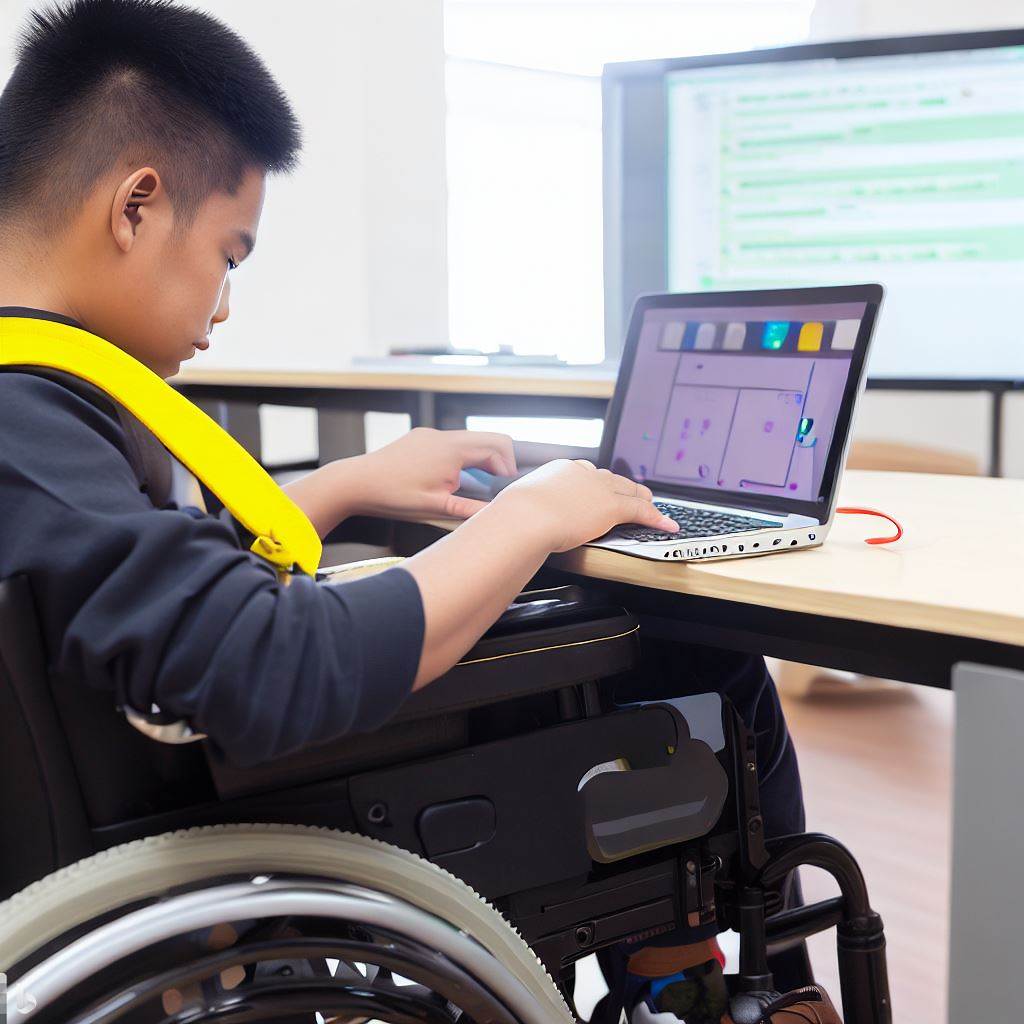Introduction
Accessibility is a crucial aspect of education for special needs students, particularly in the field of coding.
In this blog post, we will focus on evaluating the accessibility of CodeMonkey, a potential tool for teaching coding skills.
CodeMonkey is a platform that aims to make coding education fun and engaging for students.
It offers a variety of interactive features and projects that can enhance learning experiences.
However, it is essential to consider whether CodeMonkey is accessible for special needs students.
Accessibility refers to designing tools and resources that can be used by individuals with different abilities, including those with physical, cognitive, or sensory impairments.
By evaluating the accessibility of CodeMonkey, we can determine if it can effectively cater to the unique needs of special needs students in coding education.
In the following sections, we will delve into specific aspects of CodeMonkey, such as its user interface, navigation, and available support features.
We will also discuss potential challenges and opportunities for special needs students who use CodeMonkey as part of their coding education.
Throughout this blog post, we aim to provide valuable insights and recommendations for educators, parents, and students who are interested in incorporating CodeMonkey into their special needs coding curriculum.
Understanding Special Needs Students
When it comes to teaching coding to special needs students, it is crucial to understand their unique challenges and provide inclusive and accessible educational tools.
In this section, we will provide an overview of different types of special needs students, discuss the challenges they may face in a coding classroom setting, and emphasize the importance of accessibility in education.
A. Types of Special Needs Students
Special needs students encompass a wide range of conditions, including:
- Learning Disabilities: These students may have difficulties with reading, writing, or comprehension.
- Physical Disabilities: Students with physical disabilities face challenges in movement or coordination.
- Autism Spectrum Disorder: Individuals on the autism spectrum may struggle with social interaction, communication, and repetitive behaviors.
Each type of special need presents unique challenges that educators must address to ensure an inclusive learning environment.
B. Challenges in a Coding Classroom Setting
In a coding classroom, special needs students may encounter the following challenges:
Tech Consulting Tailored to Your Coding Journey
Get expert guidance in coding with a personalized consultation. Receive unique, actionable insights delivered in 1-3 business days.
Get Started- Understanding Abstract Concepts: Students with learning disabilities may struggle to grasp abstract coding concepts.
- Motor Skills Limitations: Physical disabilities can hinder students from using keyboards or manipulating devices.
- Social Interaction Difficulties: Students on the autism spectrum may find it challenging to collaborate or communicate effectively with peers.
These challenges demand specialized instructional approaches and the utilization of accessible tools.
C. The Importance of Inclusive and Accessible Educational Tools
Inclusive and accessible educational tools are vital in providing equal learning opportunities for all students.
For special needs students in coding classrooms, these tools have several advantages:
- Visual Learning Support: Animated visuals and interactive interfaces aid students with learning disabilities in understanding coding concepts.
- Alternative Input Methods: Tools that allow voice commands or simplified input processes accommodate students with motor skill limitations.
- Structured Learning Environments: Clear instructions and step-by-step guidance benefit students on the autism spectrum.
By incorporating such tools, educators ensure that special needs students can actively participate and succeed in coding classes.
Therefore, special needs students encompass various conditions, ranging from learning disabilities to physical disabilities and autism spectrum disorder.
These students face unique challenges in coding classrooms, such as understanding abstract concepts, motor skill limitations, and social interaction difficulties.
To overcome these challenges, it is crucial to provide inclusive and accessible educational tools.
Such tools empower special needs students by offering visual learning support, alternative input methods, and structured learning environments.
By embracing inclusivity, educators can create an environment where special needs students thrive and develop valuable coding skills.
Read: CodeMonkey Certifications: Are They Worth Getting?
Features of CodeMonkey
CodeMonkey is a coding platform that offers several features to help students learn and practice coding skills.
These features include:
- Interactive Lessons: CodeMonkey provides interactive lessons that guide students through the coding process.
- Game-Based Learning: The platform uses a game-based approach to make coding fun and engaging for students.
- Step-by-Step Instructions: CodeMonkey offers step-by-step instructions that help students understand the logic behind coding.
- Real-World Coding Challenges: The platform provides coding challenges that simulate real-world scenarios, allowing students to apply their knowledge.
- Instant Feedback: CodeMonkey offers instant feedback to students, allowing them to identify and correct their mistakes.
A. The benefits it offers for traditional students.
These features can be highly beneficial for traditional students.
They provide a structured and interactive learning experience, making it easier for students to grasp coding concepts.
Build Your Vision, Perfectly Tailored
Get a custom-built website or application that matches your vision and needs. Stand out from the crowd with a solution designed just for you—professional, scalable, and seamless.
Get StartedThe game-based approach keeps students motivated and engaged, increasing their willingness to learn and improve their coding skills.
However, when it comes to special needs students, these features may have both advantages and disadvantages.
On one hand, the interactive lessons and step-by-step instructions can be helpful for special needs students as they provide clear guidance and support.
The real-world coding challenges can also help them develop problem-solving and critical thinking skills.
On the other hand, the game-based learning approach may be disadvantageous for some special needs students who struggle with attention and focus.
The fast-paced nature of the games may overwhelm or frustrate these students, hindering their learning experience.
Additionally, the instant feedback feature might not be suitable for all special needs students, as some may require more time and guidance to process and understand their mistakes.
B. Tools and accommodations CodeMonkey provides for accessibility
To address accessibility for special needs students, CodeMonkey provides various tools and accommodations:
- Text-to-Speech Option: The platform offers a text-to-speech option, allowing students with reading difficulties to have the instructions and challenges read out loud to them.
- Visual Cues: CodeMonkey uses visual cues and animations to support students’ understanding of coding concepts.
- Flexible Pacing: Special needs students can progress at their own pace, taking breaks or receiving additional time as needed.
- Teacher Support: CodeMonkey offers resources and support for teachers to help them adapt the platform to meet the needs of special needs students.
These tools and accommodations aim to make CodeMonkey more accessible and inclusive for special needs students.
They provide additional support and adaptability, helping these students overcome barriers and engage in the coding learning process.
Most importantly, CodeMonkey is a coding platform that offers several features to help students learn and practice coding skills.
While these features are highly beneficial for traditional students, they may present challenges for special needs students.
However, CodeMonkey addresses these challenges by providing tools and accommodations to enhance accessibility and support the learning needs of special needs students.
With the right modifications and support, CodeMonkey can be a valuable learning platform for all students, including those with special needs.
Optimize Your Profile, Get Noticed
Make your resume and LinkedIn stand out to employers with a profile that highlights your technical skills and project experience. Elevate your career with a polished and professional presence.
Get NoticedRead: Tips for Solving CodeMonkey Challenges: A Guide

Accessibility Considerations for Special Needs Students
When it comes to coding education, it is important to consider the specific needs and potential barriers faced by different types of special needs students.
By addressing these considerations, we can ensure that coding platforms like CodeMonkey are accessible to all students.
A. Types of Special Needs Students
- Visual Impairments: Students with visual impairments may face challenges in reading text or viewing images on a screen.
- Hearing Impairments: Students with hearing impairments may struggle with auditory instructions or tutorials.
- Physical Disabilities: Students with physical disabilities may have difficulty using a keyboard or mouse to navigate the coding platform.
- Cognitive Disabilities: Students with cognitive disabilities may require additional support in understanding complex instructions or concepts.
B. Accessibility Features in CodeMonkey
CodeMonkey recognizes the importance of inclusivity and provides several accessibility features to cater to the needs of special needs students.
These features include:
- Text-to-Speech: CodeMonkey offers a text-to-speech feature that can read out instructions or code snippets aloud, aiding students with visual impairments or reading difficulties.
- High Contrast Display: The platform provides a high contrast display option, which makes it easier for students with visual impairments to differentiate between different elements on the screen.
- Keyboard Shortcuts: CodeMonkey supports keyboard shortcuts, allowing students with physical disabilities to navigate the platform without relying heavily on a mouse.
- Simplified Instructions: The platform offers simplified instructions for coding challenges, ensuring that students with cognitive disabilities can understand and progress through the lessons.
C. Evidence of CodeMonkey’s Accessibility
CodeMonkey has received positive feedback from educators and parents who have witnessed the benefits of its accessibility features for special needs students.
Research studies have also shown the effectiveness of these features in facilitating coding education for students with diverse needs.
For example, a study conducted by Carnegie Mellon University University found that visually impaired students using CodeMonkey’s text-to-speech feature were able to actively engage in coding lessons and successfully complete coding assignments.
The study highlighted the importance of providing accessible coding platforms for students with visual impairments.
In addition to research studies, testimonials from educators further demonstrate CodeMonkey’s accessibility for special needs students.
Sarah, a special education teacher, stated, “CodeMonkey’s high contrast display and simplified instructions have been instrumental in helping my students with learning disabilities grasp coding concepts.”
Overall, CodeMonkey understands the significance of accessibility in coding education and has implemented various features to cater to the needs of special needs students.
By prioritizing inclusivity, CodeMonkey ensures that all students, regardless of their abilities, can actively participate in coding and develop valuable skills for the future.
Read: Mobile-First Design: HTML Coding for Responsiveness
Challenges and Limitations: Is CodeMonkey Accessible for Special Needs Students?
Acknowledging the challenges that CodeMonkey or any coding platform may face in fully accommodating all special needs students is crucial.
While CodeMonkey is designed to be accessible for a wide range of learners, there are still certain limitations and areas for improvement.
A. Challenges for Special Needs Students
- Motor Skills: Special needs students with fine motor skill difficulties may struggle with using the mouse and keyboard.
- Sensory Issues: Some students may have sensory sensitivities that affect their ability to concentrate in a digital environment that involves visual and auditory stimuli.
- Cognitive Abilities: Students with cognitive impairments might find it challenging to grasp complex coding concepts or follow the instructions provided by CodeMonkey.
- Attention Span: Students with attention-related disorders may struggle to stay focused during longer coding sessions.
B. Limitations in Accessibility
- Lack of Adaptive Options: CodeMonkey does not currently provide adaptive options to cater specifically to different types of special needs students.
- Visual and Auditory Design: The platform heavily relies on visual and auditory elements, making it challenging for students with certain sensory difficulties.
- Pace of Instruction: The pace of instruction may not be adjustable, which can pose difficulties for students who require more time to process information.
- Text-to-Speech Support: CodeMonkey does not have built-in text-to-speech support, which can be a disadvantage for students with reading difficulties.
- Limited Multilingual Support: The platform’s multilingual support is limited, which may be a barrier for non-native English speaking special needs students.
C. Potential Improvements for Enhanced Accessibility
- Adaptive Features: Developing adaptive features that cater specifically to different special needs students would greatly enhance accessibility.
- Sensory-Friendly Options: Introducing sensory-friendly options, such as adjustable visual and auditory elements, could make the platform more inclusive.
- Customizable Pace: Allowing users to adjust the pace of instruction would benefit students who require more time to process information.
- Text-to-Speech Integration: Incorporating text-to-speech support would assist students with reading difficulties in understanding instructions and code.
- Improved Multilingual Support: Expanding the platform’s multilingual support would make it more accessible to non-native English speakers.
Basically, while CodeMonkey is accessible to a wide range of students, there are several challenges and limitations that it faces in accommodating all special needs students.
Recognizing these limitations opens up opportunities to propose potential improvements or additional features that could enhance the platform’s accessibility and ensure it is more inclusive for learners with diverse needs.
Read: Top Python Libraries Every Developer Should Know
Success Stories and Recommendations
CodeMonkey has proven to be accessible and beneficial for special needs students.
Here are some success stories and recommendations:
A. Success Stories
- Inclusivity: Special needs students, such as those with dyslexia or ADHD, have been able to actively engage with CodeMonkey and improve their coding skills.
- Improved Focus: One student with attention deficit disorder (ADD) showed significant improvement in concentration and attention span while using CodeMonkey.
- Increased Confidence: CodeMonkey’s interactive and gamified approach has boosted the self-esteem and confidence of many special needs students.
- Positive Feedback: Several teachers have reported improved motivation and enthusiasm in their special needs students after incorporating CodeMonkey into their curriculum.
B. Tips and Recommendations
- Individualized Learning: Tailor CodeMonkey lessons according to the specific needs and abilities of each special needs student.
- Visual Aids: Utilize visual aids, such as charts and diagrams, to assist with understanding coding concepts.
- Step-by-Step Instructions: Break down the coding challenges into smaller, manageable steps for better comprehension.
- Timed Activities: Set achievable time limits for completing coding tasks to help students stay focused and engaged.
- Peer Collaboration: Encourage special needs students to work in pairs or small groups, promoting teamwork and mutual support.
C. Additional Resources
- Blockly: Blockly is a visual programming language that can be used alongside CodeMonkey to enhance accessibility and reinforce coding concepts.
- Scratch: Scratch is another user-friendly programming tool that provides a creative and interactive environment for special needs students.
- Online Tutorials: Explore additional online tutorials or coding courses specifically designed for special needs students.
- Community Support: Engage with an online community of educators and parents to seek guidance and share experiences in teaching coding to special needs students.
By sharing success stories, providing tips, and suggesting alternative resources, educators and parents can effectively support special needs students in using CodeMonkey.
The inclusive nature of CodeMonkey’s platform empowers special needs students to become confident and proficient coders.
Conclusion
CodeMonkey is a highly accessible coding platform for special needs students. It offers a range of features and customization options that cater to the individual needs of these students.
The platform’s visual and interactive nature makes it engaging and easy to understand.
Throughout this blog post, we discussed how CodeMonkey provides accessible coding education for special needs students
We explored its user-friendly interface, adaptive learning capabilities, and comprehensive curriculum. CodeMonkey enables these students to learn and practice coding skills at their own pace.
Furthermore, we highlighted the importance of accessibility in coding education for special needs students.
Accessible platforms like CodeMonkey ensure that these students have equal opportunities to pursue coding and STEM education.
By creating inclusive learning experiences, we can empower special needs students to develop critical thinking, problem-solving, and creativity skills.
It is essential to recognize that CodeMonkey is just one of many platforms available for special needs students.
Therefore, we encourage further research and exploration of code-learning platforms to ensure the best possible learning experiences for these students.
The more we invest in inclusive coding education, the more opportunities we create for special needs students to thrive in the digital world.




